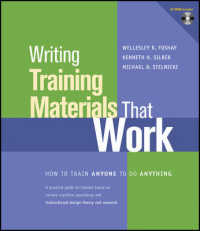- ホーム
- > 洋書
- > 英文書
- > Literary Criticism
Full Description
Volume 6 of The Cambridge History of American Literature explores the emergence and flowering of modernism in the United States. David Minter provides a cultural history of the American novel from the 'lyric years' to World War I, through post-World War I disillusionment, to the consolidation of the Left in response to the mire of the Great Depression. Rafia Zafar tells the story of the Harlem Renaissance, detailing the artistic accomplishments of such diverse figures as Zora Neal Hurston, W. E. B. Du Bois, Langston Hughes, Nella Larsen, and Richard Wright. Werner Sollors examines canonical texts as well as popular magazines and hitherto unknown immigrant writing from the period. Taken together these narratives cover the entire range of literary prose written in the first half of the twentieth century, offering a model of literary history for our times, focusing as they do on the intricate interplay between text and context.
Contents
Acknowledgments; Introduction Sacvan Bercovitch and Jonathan Fortescue; I. A cultural history of the modern American novel David Minter: Prologue; Part I. A Dream City, Lyric Years, and a Great War: 1. The novel as ironic reflection; 2. Confidence and uncertainty in The Portrait of a Lady; 3. Lines of expansion; 4. Four contemporaries and closing of the west; 5. Chicago's 'Dream City'; 6. Frederick Jackson Turner in the dream city; 7. Henry Adams's Education and the grammar of progress; 8. Jack London's career and popular discourse; 9. Innocence in the 'Lyric Years': 1900-1916; 10. The Armory Show of 1913 and the decline of innocence; 11. The play of hope and despair; Part II. Fiction in a Time of Plenty: 12. When the war was over: the return of detachment; 13. The 'Jazz Age' and the 'Lost Generation' revisited; 14. The perils of plenty, or how the Twenties acquired a paranoid tilt; 15. Disenchantment, flight, and the rise of professionalism in an age of plenty; 16. Class, power, and violence in a new age; 17. The fear of feminization and the logic of modest ambitions; 18. Marginality and authority/race, gender and region; 19. War as metaphor: the example of Ernest Hemingway; Part III. The Fate of Writing During the Great Depression: 20. The discovery of poverty and the return of commitment; 21. The search for 'culture' as a form of commitment; 22. Three responses: the examples of Henry Miller, Djuna Barnes, and John Dos Passos; 23. Cowboys, detectives and other tough-guy antinomians: residual individualism and hedged commitments; 24. The search for shared purpose: struggles on the left; 25. Documentary literature and the disarming of dissent; 26. The southern renaissance: forms of reaction and innovation; 27. History and novels/novels and history: the example of William Faulkner; II. Fictions of the Harlem Renaissance Rafia Zafar: 1. A new Negro?; 2. Black Manhattan; 3. Avatars and Manifestos; 4. At home and homeless in Harlem; 5. New Negro, New Woman; 6. Thurman and Nugent; 7. Minor writers; 8. Hurston and Wright; 9. Black Modernism; III. Ethnic Modernism Werner Sollors: Introduction; 1. Gertrude Stein and 'Negro Sunshine'; 2. Ethnic lives and 'lifelets'; 3. Ethnic themes, modern themes; 4. Mary Antin: progressive optimism against odds; 5. Who is 'American'?; 6. American languages; 7. 'All the past we leave behind'? Ole E. Rølvaag and the immigrant trilogy; 8. Modernism, ethnic labeling; and the quest for wholeness: Jean Toomer's new American race; 9. Freud, Marx, hard-boiled; 10. Hemingway spoken here; 11. Henry Roth: ethnicity, modernity, and modernism; 12. The clock, the salesman and the beast; 13. Was modernism anti-totalitarian; 14. Facing the extreme; 15. Grand central terminal.








